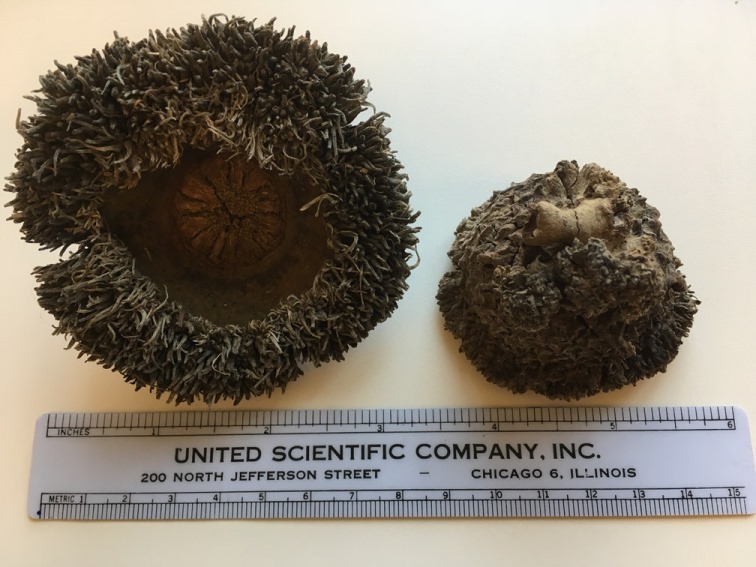“What is this thing???”
We often hear this question from friends and family in relation to natural “treasures” found in the landscape. Sticks, leaves, flowers, fruit, fungi, lichens, moss. You name it, somebody has likely brought it to BRIT for identification at some point (or emailed us a photo).
This time we feature the crazy, gargantuan, monster acorn caps from the bur oak tree (Quercus macrocarpa).


Bur oak is native to the central and eastern US, including most of the middle swath of Texas, top to bottom. This fast-grower typically likes an open, limestone or chalky clay habitat and is adapted not only to fire and drought but also to extreme cold and flooding. You can find it in the prairies and savannas as well as along waterways. So basically it’s a super champ of trees, which is why it’s common in cultivation.
And as you can see above, THE CAPS OF ITS ACORNS ARE WEIRD, mostly because they’re just so big. Bigger than we’re used to seeing relative to what we think of as lil’ ol’ acorns. But they’re also weird because of the shaggy ornamentation encircling the cap. This is a feature that can vary over the tree’s range. Caps in the southern portion have long fringe hairs while others at the far north of its range are much smaller and barely have any shag at all. The caps seen above have what one might call “average shag.” The shagginess and the size of the cap are the reason for one of the tree’s other common names: mossy-cup oak. To me, because the size of the cap often dwarfs the little acorn attached, it resembles one of those big Russian fur hats (which Google tells me is called a “ushanka”…think George Costanza’s “leave behind” hat).

There’s another oak, Quercus lyrata (overcup oak), that the bur oak can sometimes be confused with—their ranges overlap a bit in East Texas, they can hybridize, and overcup oak also has an acorn cap that wraps much of the way around the acorn (hence its common name).





I mean, LOOK at the size of these things! You know that scene in Honey, I Shrunk the Kids where the kids are tiny and running around in the yard, and they happen upon a crumb from an oatmeal creme pie, and it’s as big as a house? That must be what it’s like for a squirrel to eat these acorns! But they’re not just a treat for the wee animals. American black bears also consider them worthy snacks, breaking off branches to get to those still attached to the tree.



So why the big cap? Why the big fruit? The Latin name macrocarpa translates to “large fruit.” The acorns of bur oak are the largest of all the native oaks. But making fruit this big is energy-intensive; it’s expensive to the tree. So bur oaks use a strategy called masting (=”synchronous and intermittent reproduction”) where large nut crops are produced only every few years in order to overwhelm seed predators, making more than could be eaten in a single season and hoping that some will survive to become new trees. Many oaks do this. Serendipitously, the MinuteEarth channel on YouTube just posted a new video on this very topic (When Trees Go Nuts – YouTube).
This doesn’t exactly explain why individual bur oak acorns are BIGGER than acorns from other oak species, but the evolutionary advantages of any large-fruited plant are somewhat related to the idea of masting: fruit/seed predators are given more than they can possibly consume in total, hopefully leaving some fruit and seeds intact to germinate and contribute to the next generation. Think of the strategy of making few big watermelons versus hundreds of little grapes. That may be what’s going on here. Why do you think the acorns are so big?
Excerpt from Shinners & Mahler’s Illustrated Flora of North Central Texas (1999):
Quercus macrocarpa Michx., (large-fruited), BUR OAK, MOSSY-CUP OAK, PRAIRIE OAK, MOSSYOVERCUP OAK. Large tree; nuts and cups (3-6 cm wide) largest of all nc TX species. Stream bottoms, lower slopes, upland woods; usually in at least moderately drained places; in or near limestone areas; se and e TX w to West Cross Timbers and Edwards Plateau. This species is well known for its large acorns and thick, fire-resistant bark.
Links to more info on the species…
- Information from the Ladybird Johnson Wildflower Center: https://www.wildflower.org/plants/result.php?id_plant=quma2
- Distribution in the US: https://plants.usda.gov/core/profile?symbol=quma2
- Wikipedia: https://en.wikipedia.org/wiki/Quercus_macrocarpa
- iNaturalist: https://www.inaturalist.org/taxa/54781-Quercus-macrocarpa
- Ethnobotany: http://naeb.brit.org/uses/search/?string=quercus+macrocarpa
- Flora of North America: http://www.efloras.org/florataxon.aspx?flora_id=1&taxon_id=233501058
So keep bringing us your weird and wonderful treasures! We’ll do our best to turn them into teaching moments that benefit us all. Happy botanizing!
References:
- Arborilogical Services, Inc. 2010. “Bur Oak – Could it be our best fast-growing shade tree?“
- Diggs, GM, BL Lipscomb & RJ O’Kennon. 1999. Shinners and Mahler’s Illustrated Flora of North Central Texas. Sida, Bot. Misc. 16. Botanical Research Institute of Texas, Fort Worth, Texas, USA. link
- Kelly, D. 1994. The evolutionary ecology of mast seeding. Trends in Ecology & Evolution 9(12):465-470. https://doi.org/10.1016/0169-5347(94)90310-7.
- Nixon, KC. 1997. Quercus macrocarpa. In: Flora of North America North of Mexico. Volume 3.






